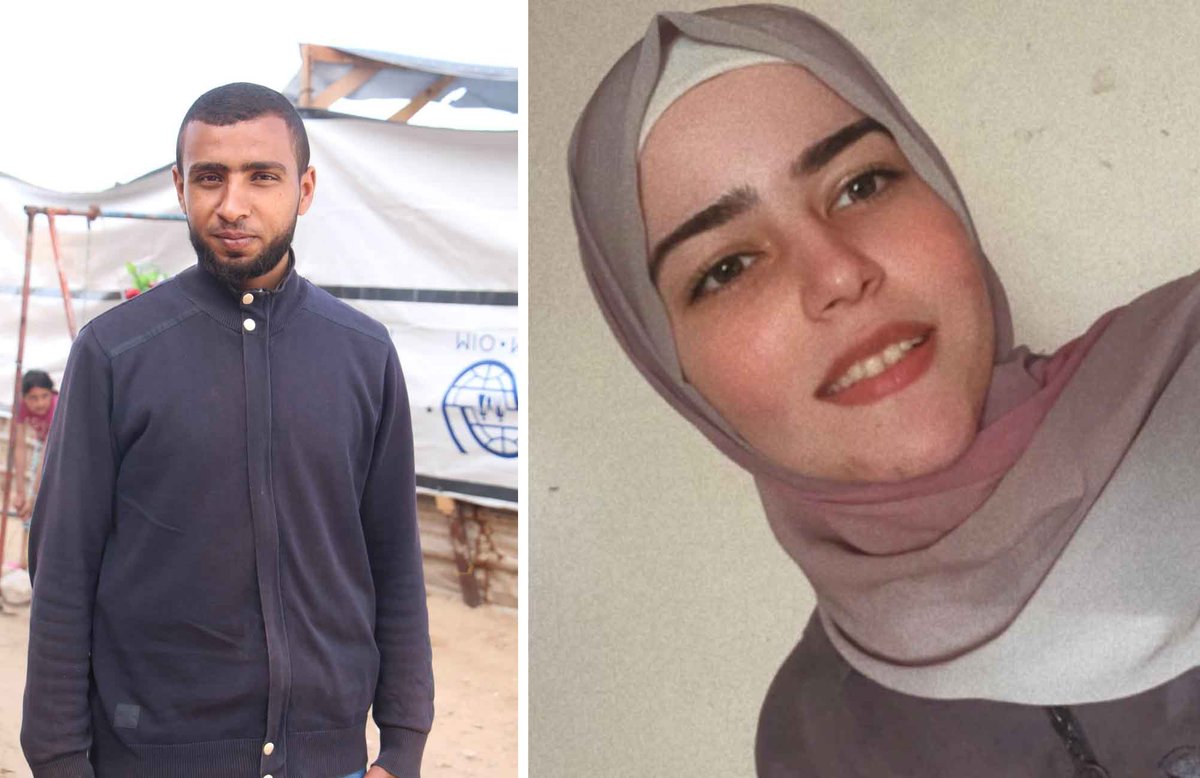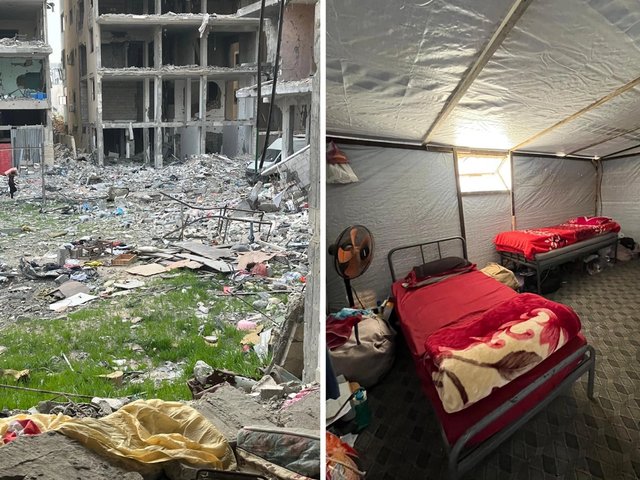Archaeology students at the Islamic University of Gaza are continuing their studies amid relentless Israeli bombardments, destruction of their university, lack of electricity, water shortages and scarcity of food and essentials.
Since last year, students have relied on online learning to pursue their degrees, which are taught by experts from inside and outside Gaza. This approach began as a Covid-era solution and now offers a fragile lifeline to education during a war with no end in sight.
“We believe that knowledge is the strongest weapon to face challenges, and that every moment we study gives us new hope for a better future,” Leena Majed Yassin, a 24-year-old final year archaeology student, tells The Art Newspaper. “The truth is that resilience is not just a choice, but a necessity we live every day,” she adds.
Most mornings, when not helping her mother search for water, collect firewood or cook over an open flame, Yassin tries to read her notes. Study material is shared by lecturers as PDFs or audio recordings. Sometimes videos are provided too, but the lack of electricity and unstable internet often prevent her from watching them in full. She communicates with lecturers via WhatsApp or email, but access to power and internet similarly dictates when she can reach them and receive replies. “I study where I can, not when I want,” she says.
The constant threat of explosions adds to the strain. “No one ever gets used to the sound of bombs or the buzzing of drones. The explosions always catch us off guard—they frighten us, scatter the books from our hands, and shake our hearts,” she says. “I try to gather myself and return to studying after the noise settles, but fear doesn’t go away easily,” she says, noting that three students on her course have been killed.
The blockade of aid by Israel into Gaza since March has worsened the dire situation, making food scarce. At the end of May, Israel temporarily lifted the ban to allow limited UN aid into Gaza before transferring distribution to an American and Israeli backed organisation, the Gaza Humanitarian Foundation (GHF), despite objections by the UN and other humanitarian organisations. GHF operates from a handful of hubs inside Israeli military zones and has been at the centre of controversary, with the UN calling for a probe into shootings at its centres on 1 June that reportedly killed more than 30 Palestinians and wounded hundreds.
Aid delivered by GHF reached only a trickle of those in need, and on 3 June, the Israeli military declared roads leading to GHF centres combat zones, warning residents against travelling to them. It later restricted access to between 6am and 6pm and designating all other times as an “active combat zone”. Reports of shootings and killing of Palestinians at or near the GHF centres continue to emerge almost daily, with more than 400 people reportedly killed since the end of May.
Yassin says the “American aid” is a “deadly trap” that has made no actual difference in people’s lives but instead has added to their suffering.
The conflict between Israel and Iran has further dimmed hopes for a ceasefire in Gaza—one that could ease aid restrictions and bring much-needed relief.
“Many days, we don’t have enough to eat. And how can a hungry mind focus on a lecture or solve an equation?” she continues. “Still, I try. Not for any reason other than my refusal to be defeated.”
Another student on her course, 24-year-old Sohaib Hisham Al-Koulak, says he has been displaced nearly 50 times. After losing his home, he now lives in a tent with 13 family members, including his sister, whose husband was killed, and her four small children.
Every morning, he wakes at dawn to study material he downloaded previously after walking for kilometres to reach an internet spot. But the crowded tent and constant disruption make it impossible to focus.
“Before this brutal war started, I used to attend university like any other student in the world,” Al-Koulak, who is top of his class, tells The Art Newspaper. Israel’s blockade has added soaring prices of goods to his list of challenges. He says that printing one set of his notes costs around $40, and even charging his phone via solar panels is expensive—money he does not have.
“Despite all that, I want to continue my studies. I wish to finish my bachelor’s degree, then study for my master’s and doctorate like any student in the world,” Al-Khoulak says. “If life allows me to live and stay here, I hope to become a great professor and scholar.”
Mustafa Sameer Abdo Badawi was also among the university’s top students. The 24-year-old was in his third year when the war began and “crushed all dreams”. In November 2023, he was seriously injured while searching for his 22-year-old brother in a market during a bombing. His brother was killed, Badawi suffered shrapnel wounds, a broken foot and burns. Metal plates were inserted into his ankle, but shrapnel remains in his body causing ongoing pain and medical complications. He needs surgeries that are currently unavailable in Gaza. Despite his injuries, displacement, and personal loss, Badawi resumed his studies when courses reopened online.

Mustafa Sameer Abdo Badawi studying before the war
Photo: Mustafa Sameer Abdo Badawi
“I study, read, and work hard on my lectures amid the bombings, the sound of drones, and the noise of bullets and intense shelling,” he explains, carrying academic notes from one displacement site to another. “I find myself living between two fears, the fear of failing my exams and the fear of the heavy bombardment,” he says.
Like many of his fellow students, Badawi is struggling to afford tuition and study-related costs—including costly internet, which requires him to “travel far and under dangerous conditions.” Despite these conditions, students at the Islamic University of Gaza must still pay their fees to receive their degrees.
The university has itself been decimated. The private institution, which is Gaza’s oldest university, was bombed by Israeli forces in the early days of the war. Several members of staff have been killed, including its president, Sofyan Taya—a respected scholar who held the Unesco Chair for physical and astrophysical sciences—and his family.

The Islamic University of Gaza, which has been acting as a shelter for hundreds of displaced families
In recent months, what remains of the site has been acting as a shelter for hundreds of displaced families in northern Gaza.
Israel has said its reason for targeting universities in Gaza is because it believes Hamas militants are using them for military activity, and that attacks were launched from the Islamic University’s campus. Israel has denied inflicting unnecessary damage.
All 17 of Gaza’s universities and colleges have been devastated by Israeli bombardments and ground offensives.
An institution in crisis
Rami Marjan, the vice-dean of the faculty of science and head of the student support committee, confirms the university began collecting partial tuition fees after initially waiving them for the first online semester. This decision was made, he tells The Art Newspaper, to ensure learning could continue. Marjan explains that non-profit and non-governmental institutions like the Islamic University, rely primarily on student fees to cover education costs, including basic academic operations.
The university has faced financial difficulties since before the war, he says, with staff salaries cut by around 50% since 2013. These problems have been compounded over the past 20 months. “The university has struggled even to cover the costs of running online learning, which include platform fees, server rentals, and many other essential requirements,” Marjan says.
He highlights that today, university staff in Gaza receive only about $200 a month, and some have been left with “no income at all”. “University employees can’t survive without any income,” he continues. He adds that a lack of aid and funding has left his own family only eating just one meal a day for the past two months. Charging students “part of the fees,” he says, was “a difficult decision for the university — but they had no other option.”
What is being done to help the students?
A fundraiser to help cover the students’ tuition fees has been set up in the UK by Georgia Andreou, one of the archaeology course’s former project leaders. Andreou was director of the Gaza Maritime Archaeology Project (Gazamap), an initiative that ran during the summer of 2022 and 2023 to examine and survey Gaza’s coastal sites as part of a wider project on endangered maritime cultural heritage in the Middle East and North Africa, run by the University of Southampton and Ulster University in partnership with the University of Oxford.
The archaeology students played a vital role in Gazamap, helping to record more than 20,000 surface finds from Gaza’s archaeological coastal sites.
“Some may say, why raise money for tuition fees when people are going hungry? But this is what the students want. They want to study and complete their degrees,” Andreou tells The Art Newspaper.
The fundraiser aims to raise £9,630 ($12,790) to help 12 students cover their fees. Andreou says it forms part of wider efforts by academics to support the students through mentoring, scholarship advice and academic guidance.
In the meantime, many students remain hopeful. “I am a student from Gaza. I am trying to learn amidst the ashes. And I dream of becoming a voice for history - not a forgotten victim of it,” says Yassin.






